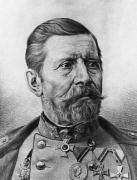Franz von Uchatius
Franz von Uchatius (1811–1881) was an Austrian artillery general and inventor. His inventions included both military applications and pioneer work in cinematography.

He invented a motion picture projector in 1853,[1] developing it over the years from 1845[2] from the device then called stroboscope (Simon von Stampfer)[3] and phenakistiscope (Joseph Plateau).[4] This was the first example of projected animation,[5] demonstrated in 1853;[6] it is also described as the combination of the zoetrope with the magic lantern.[7] It was called the kinetoscope,[8] a term later used by Thomas Edison (see kinetoscope). He applied it to lecture on ballistics.[9]
He worked also on a smokeless powder,[10] improved cannons and alloys (his steel bronze was a copper-tin alloy[11]), Uchatius steel was produced industrially, by mixing granulated iron with iron oxide.[12]
His balloons,[13][14] were the earliest recorded use of an unmanned aerial vehicle for warfighting occurred on July 1849,[15][16] serving as a balloon carrier (the precursor to the aircraft carrier)[17] in the first offensive use of air power in naval aviation.[18][19][20] Austrian forces besieging Venice attempted to float some 200 incendiary balloons, each carrying a 24- to 30-pound bomb that was to be dropped from the balloon with a time fuse over the besieged city. The balloons were launched mainly from land; however, some were also launched from the Austrian ship SMS Vulcano. The Austrians used smaller pilot balloons to determine the correct fuse settings. At least one bomb fell in the city; however, due to the wind changing after launch, most of the balloons missed their target, and some drifted back over Austrian lines and the launching ship Vulcano.[21][22][23]
Notes
- Motion Pictures – The Invention Of Motion Pictures. Science.jrank.org. Retrieved on 18 December 2011.
- Film Principles Class Notes. Angelfire.com (10 April 2002). Retrieved on 18 December 2011.
- Adventures in CyberSound: Magic Machines: 1826 – 1875 Archived 3 September 2007 at the Wayback Machine. Acmi.net.au. Retrieved on 18 December 2011.
- Adventures in CyberSound: von Uchatius, Franz Archived 4 September 2007 at the Wayback Machine. Acmi.net.au (21 January 1912). Retrieved on 18 December 2011.
- Chronology of Animation: Beginning Archived 20 August 2007 at the Wayback Machine
- Chronomedia: 1850–1854. Terramedia.co.uk (25 August 2008). Retrieved on 18 December 2011.
- An Historical Timeline of Computer Graphics and Animation Archived 29 June 2007 at the Wayback Machine. Sophia.javeriana.edu.co. Retrieved on 18 December 2011.
- Cartoons – The golden era, The television era. Filmreference.com. Retrieved on 18 December 2011.
- William Everdell, The First Moderns (1997), 13–14.
- Hodgkinson, William Richard Eaton (1911). . In Chisholm, Hugh (ed.). Encyclopædia Britannica. 6 (11th ed.). Cambridge University Press.
- Chisholm, Hugh, ed. (1911). . Encyclopædia Britannica. 4 (11th ed.). Cambridge University Press. pp. 639–640.
- The Household Cyclopedia – Metallurgy Archived 12 October 2007 at the Wayback Machine. Mspong.org. Retrieved on 18 December 2011.
- Important Events in Military Aeronautic History
- WNYC – Books: Survival City: Adventures among the Ruins of Atomic America Archived 30 September 2005 at the Wayback Machine
- Air Power in the Age of Total War, John Buckley
- The Future of Drone Use: Opportunities and Threats from Ethical and Legal Perspectives, Asser Press - Springer, chapter by Alan McKenna, page 355
- Naval Aviation in the Second World War, Philip Kaplan
- Taking Flight: Inventing the Aerial Age, from Antiquity through the First World War, Richard P. Hallion, page 66
- Naval Aviation in the First World War: Its Impact and Influence, R. D. Layman, page 56
- Broken Wings: The Hungarian Air Force, 1918-45, Stephen L. Renner, page 2
- Military Aircraft, Origins to 1918: An Illustrated History of Their Impact, Justin D. Murphy, pages 9–10
- Military Ballooning During the Early Civil War, The Johns Hopkins University Press, F. Stansbury Haydon, pages 18–20
- Mikesh, Robert C. "Japan's World War II balloon bomb attacks on North America." (1973).